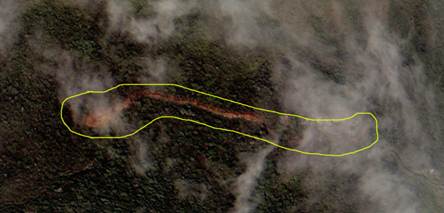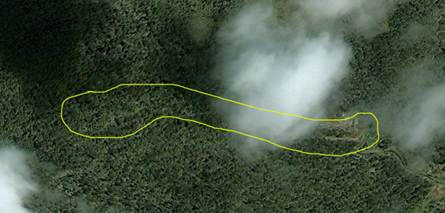


BIRD DIVERSITY OF THE HAYES-GONGALA FOREST AND THE FIRST RECORD OF THE BLACKBIRD Turdus simillimus kinnisii IN THE SABARAGAMUWA HILLS
Uditha Hettige1,2, Dulan Ranga Vidanapatirana2 M.D. Gehan Rajeev2
1. Ceylon Bird Club, 2. Hepetological Foundation
Abstract
A forested area covers parts of the Gongala mountain ridge between c. 600 and 1,357 m at the edge of the wet zone of Sri Lanka. It harbours a high biodiversity due to its position and varied altitude. The first record of the Blackbird Turdus simillimus kinnissii in the Sabaragamuwa Hills was established here in 2012 on June 2. Although of high ecological value, the forest is unprotected by law. It has recently been much harmed by man-made constructions and is under more threat from these. Further damage, it is suggested, can be minimized.
Location
The Sabaragamuwa Hills, also known as the Rakwana Range or Massif, are one of Sri Lanka’s three main mountain ranges, lying South and South-West of the Central Hills, in the Sabaragamuwa and Southern Provinces. Hayes Estate, a tea plantation, and Gongala Peak, the highest point in the forested area studied, at 6°23’9”N and 80°39’15”E, are on a ridge at its Eastern end. The growth lower on it is secondary and natural forest starts at c. 1,000 m in most places, c. 900 in some. The ridge extends West to Enselwatte Estate (also tea).
Habitats
Within the tea at Hayes Estate are small forested areas, especially in valleys and along a stream. Some of these are forest reservations, left intact by policy in a former era of tea planting in Sri Lanka. In the upper parts of the Estate is a large extent of natural forest. This is used to grow cardamom, which has replaced the natural undergrowth, but has left rest of the forest intact. The higher parts of the range, including Gongala Peak, are covered by natural forest.
The southern slope of the mountain ridge is exposed to very humid and strong winds, especially during the South-West monsoon. These have carved the vegetation into a submontane forest with a montane physiognomy (i.e. the appearance of a montane forest). Most plant species found by us were submontane. There is good forest cover with heavy undergrowth in the slopes, mainly Nelu Strobilanthus spp. The canopy is less than 10 m high. At the top of the ridge are rocky outcrops with boulders
Avifauna
There were a considerable number of bird species in the study area, as listed in the Appendix, including several endemics.
Yellow-eared Bulbul, Blackbird, Dusky-blue Flycatcher, Grey-headed Flycatcher and Ceylon Hill White-eye were some of the montane and submontane species recorded by us.
The Blackbird, whose subspecies in Sri Lanka is endemic to the island, is stated by Warakagoda et al., 2012 to be “uncommon to locally rather common” in the upper parts of the Central Range and the Knuckles Range, the third main massif. In Henry, 1998 it is said to occur in “the higher hills...about 3,000 feet upwards”.
Legge, 1883, stated: “it is an inhabitant of the entire hill portion of the Kandyan Province, from the loftiest regions down to an elevation of between 2500 and 3000 feet; it is, I am given to understand, likewise found on the uppermost parts of the Morowak and Kolonna Korales, but I have not seen specimens myself from that district”. His “Kandyan” region covers the Central and Knuckles Hills. Since that time the species had not been recorded outside these, as implied above. It is remarkable that the present observation establishes its existence, very probably continuous since then, in exactly the additional area described by Legge: the Gongala ridge lies in the highest parts of the two Korales named, and the bird was seen on the second.
The Blackbird is primarily a forest bird and is generally found on the forest floor feeding on insects. The song of the male is quite pleasant and generally can be heard from the undergrowth of the montane forests, during the early hours of the morning as well as during dusk.
In the present study, at the lower elevations of the forested area visited were endemic species such as Ceylon Small Barbet, Ceylon White-headed Starling and Ceylon Grey Hornbill. In the lowest areas, species such as Large Prinia, Small Minivet and White-browed Fantail were found.
The very high biodiversity in the forest, apart from the avifauna, is indicated by our study of reptiles and amphibians. Several endemic species of lizard were found.
Methods, equipment
All observations were carried out on foot, and when at night (mostly in the cardamom-planted areas) mainly using red flashlights. The supply road (see below) was used as the primary observation route. Walks were done along streams, footpaths etc. for more in-depth observation of the forest. Optics used: Swarowski 8.5x42 EL binocular. Altitudes, co-ordinates and distances were obtained using Google Maps.
Harm, threats
The top of the ridge overlooks the entire Eastern side and part of the Southern side of the island beyond the Sabaragamuwa Hills: areas such as Udawalawa, Embilipitiya, Morawaka, Deniyaya, Hambantota and Wirawila. It is thus ideal as an electronic signal transmission site. On it are several TV, radio and telecommunication towers. These have destroyed part of the prime habitat. In 2010 the Metrological Department cleared a 420 m long, 3-5 m wide road to a new weather centre. A very tall building for this purpose was completed in May 2012.
Other institutions of the private and State sectors are likely to clear more of this forest to put up transmission towers. Since the best-preserved forest is along the top of the ridge they will destroy its most valuable part.
Clearing more forest will cause a threat to the structures themselves. The very steep slopes will be still more vulnerable to landslides. Building more towers will threaten the existence of all of them. This threat is already visible in some areas.

2010 Google Earth image of Gongala peak
with new site and supply road to meteorological weather centre.

2006 Google Earth image of Gongala peak.
Marked is the same area 4 years back.
Discussion, suggestions
The wet-zone forests of Sri Lanka contain very high biodiversity and high species endemicity. The percentage of the island’s land area covered by these is very small. The total area of these protected by law is still smaller. Of their unprotected areas some are in prime condition. Others have deteriorated, even after the Flora and Fauna Protection Ordinance, due to uncontrolled tea planting, other farming practices and unplanned development.
The ecosystem of the present study is known to be restricted to the Sabaragamuwa Hills. The forest harbours a large number of species endemic not only to Sri Lanka but to the still more limited region.
An important fact is that this forest connects to a larger forest area, Sinharaja, on its Western side. While benefitting the biodiversity of both areas by enhancing their gene pools, the link gives more stability to this forest, which is especially vulnerable due to its narrow, elongated extent and form. It is very important to preserve and protect this continuity.
We would suggest that this forest should be given protected status by the Department of Forest Conservation, by declaring it a Forest Reserve. We would further suggest that a larger continuous extent of forest be thus protected, including the Handapan Ella and Sellakanda areas. At present the protection of the area studied is effected by the Sri Lanka Navy, which restricts access to the towers.
In the modern world, and as a developing country, we need telecomunication facilities. But already there are more than five transmission towers at Gongala. There will be more to come. The best solution will be to have common towers by a State directive. The existing towers, enlarged if necessary, and even the weather tower can be utilized in this way. That will stop further destruction of this forest.
Acknowledgements
The authors wish to thank the staff of Hayes Estate for allowing the study, Mr R.M. Saman Priyantha who provided accommodation, the Sri Lanka Navy for permission to visit Gongala Peak, Mr Mendis Wikramasinghe who arranged the trip and permission, Google Maps for their facilities used in this paper, and Mr Udaya Siriwardana for guidance in editing it.
References
Wijesinghe, D. P. 1994. Checklist of the Birds of Sri Lanka. Special Publication No. 2, Ceylon Bird Club, Colombo.
Grimmett, R., Inskipp, C. and Inskipp, T. 1999. A Guide to the Birds of India, Pakistan, Nepal, Bangladesh, Bhutan, Sri Lanka, and the Maldives. Princeton University Press, Princeton, New Jersey.
Harrison J and Worfolk T (1999); A Field Guide to the Birds of Sri Lanka, Oxford University Press, Oxford.
Henry, G.M. 1998. A Guide to the Birds of Sri Lanka Third edition. Kandy: K.V.G. de Silva and Sons and New Delhi: Oxford University Press.
IUCN & MoENR (2007): The 2007 Red List of Threatened Flora and Fauna of Sri Lanka, IUCN Sri Lanka and the Ministry of Environment & Natural Resources, Colombo, Sri Lanka
Legge, W.V. 1883 A History of the Birds of Ceylon, 2nd ed. Vols. 1,2,3 and 4. Tisara Prakasakayo Ltd. Dehiwala, Sri Lanka.
Rasmussen P.C. & Anderton J.C. 2005. Birds of South Asia. The Ripley Guide, Vols. 1 and 2. Smithsonian Institution and Lynx Edicions, Washington, D.C. and Barcelona.
Warakagoda D and Hettige U (2008);Birds of Sri Lanka, mp3 sound and image collection on cd-rom-ver-1, Bird Sounds.nl, Netherlands.
Warakagoda, D., Inskipp, C., Inskipp, T. and Grimmett, R. 2012; Birds of Sri Lanka, Christoper Helm, an imprint of Bloomsbury Publishing Plc, London.
Ceylon Bird Club. 2011. Sri Lanka List (Country List) of bird species. http://www.ceylonbirdclub.org
Appendix - List of birds
Abbreviations : R - resident, M - migrant, R/M - part of the population is resident while the other part of the population is migrant
CORMORANTS AND SHAGS PHALACROCORACIDAE
Little Cormorant Phalacrocorax niger R
HERONS AND EGRETS ARDEIDAE
Little Egret Egretta garzetta R
Large Egret Egretta alba R
Median Egret Egretta intermedia R
Cattle Egret Bubulcus coromandus R/M
Indian Pond Heron Ardeola grayii R/M
HAWKS, KITES, EAGLES AND VULTURES ACCIPITRIDAE
Crested Honey Buzzard Pernis ptilorhynchus R/M
Brahminy Kite Haliaster indus R
Crested Serpent Eagle Spilornis cheela R
Shikra Accipiter badius R
Black Eagle Ictinaetus malayensis R
Crested Hawk-Eagle Spizaetus cirrhatus R
PARTRIDGES, QUAILS AND PHEASANTS PHASIANIDAE
Ceylon Junglefowl Gallus lafayetii E
BUTTON QUAILS TURNICIDAE
White-breasted Waterhen Amaurornis phoenicurus R
Red-wattled Lapwing Vanellus indicus R
PIGEONS AND DOVES COLUMBIDAE
Rock Pigeon Columba livia R
Spotted Dove Streptopelia chinensis R
Emerald Dove Chalcophaps indica R
Pompadour Green Pigeon Treron pompadora E
Green Imperial Pigeon Ducula aenea R
PARROTS PSITTACIDAE
Ceylon Lorikeet Loriculus beryllinus E
Rose-ringed Parakeet Psittacula krameri R
Layard's Parakeet Psittacula calthropae E
CUCKOOS CUCULIDAE
Common Coucal Centropus [sinensis] parroti R
Indian Koel Eudynamys scolopaceus R
SWIFTS APODIDAE
Edible-nest Swift Aerodramus unicolor R
Palm Swift Cypsiurus balasiensis R
House Swift Apus affinis R
TREE SWIFTS HEMPROCNIDAE
Crested Tree Swift Hemiprocne coronata R
KINGFISHERS ALCEDINIDAE
White-breasted Kingfisher Halcyon smyrnensis R
BEE-EATERS MEROPIDAE
Chestnut-headed Bee-eater Merops leschenaulti R
HORNBILLS BUCEROTIDAE
Ceylon Grey Hornbill Ocyceros gingalensis E
BARBETS CAPITONIDAE
Brown-headed Barbet Megalaima zeylanica R
Yellow-fronted Barbet Megalaima flavifrons E
Ceylon Small Barbet Megalaima rubricapillus E
WOODPECKERS PICIDAE
Pygmy Woodpecker Dendrocopos nanus R
Red-backed Woodpecker Dinopium benghalense psarodes R
Crimson-backed Woodpecker Chrysocolaptes stricklandi E
LARKS ALAUDIDAE
Jerdon’s Bushlark Mirafra affinis R
SWALLOWS AND MARTINS HIRUNDINIDAE
Ceylon Swallow Hirundo hyperythra E
PIPITS AND WAGTAILS MOTACILLIDAE
Indian Pipit Anthus rufulus R
CUCKOO-SHRIKES AND MINIVETS CAMPEPHAGIDAE
Black-headed Cuckoo-Shrike Coracina melanoptera R
Small Minivet Pericrocotus cinnamomeus R
Orange Minivet Pericrocotus flammeus R
Pied Flycatcher-Shrike Hemipus picatus R
FANTAILS RHIPIDURIDAE
White-browed Fantail Rhipidura aureola R
BULBULS PYCNONOTIDAE
Black-capped Bulbul Pycnonotus melanicterus E
Red-vented Bulbul Pycnonotus cafer R
Yellow-eared Bulbul Pycnonotus penicillatus E
White-browed Bulbul Pycnonotus luteolus R
Yellow-browed Bulbul Iole indica R
Black Bulbul Hypsipetes ganeesa R
IORAS AEGITHINIDAE
Common Iora Aegithina tiphia R
LEAFBIRDS CHLOROPSEIDAE
Gold-fronted Chloropsis Chloropsis aurifrons R
THRUSHES TURDIDAE
Spotted-winged Thrush Zoothera spiloptera E
Ceylon Scaly Thrush Zoothera imbricata E
Blackbird Turdus simillimus R
OLD-WORLD FLYCATCHERS AND CHATS MUSCICAPIDAE
Dusky-blue Flycatcher Eumyias sordidus E
Tickell’s Blue Flycatcher Cyornis tickelliae R
Grey-headed Flycatcher Culicicapa ceylonensis R
Magpie-Robin Copsychus saularis R
Black Robin Saxicoloides fulicatus R
BABBLERS TIMALIIDAE
Brown-capped Babbler Pellorneum fuscocapillus E
Ceylon Scimitar Babbler Pomatorhinus melanurus E
White-throated Babbler Dumetia hyperythra R
Black-fronted Babbler Rhopocichla atriceps R
Southern Common Babbler Turdoides affinis R
CISTICOLAS, PRINIAS AND TAILORBIRDS CISTICOLIDAE
Streaked Fantail Warbler Cisticola juncidis R
Ashy Prinia Prinia socialis R
Large Prinia Prinia sylvatica R
White-browed Prinia Prinia inornata R
Common Tailorbird Orthotomus sutorius R
TITMICE PARIDAE
Grey Tit Parus cinereus R
NUTHATCHES SITTIDAE
Velvet-fronted Nuthatch Sitta frontalis R
FLOWERPECKERS DICAEIDAE
Tickell’s Flowerpecker Dicaeum erythrorhynchos R
SUNBIRDS NECTARINIIDAE
Purple-rumped Sunbird Leptocoma zeylonica R
Loten’s Sunbird Cynnyris lotenius R
WHITE-EYES ZOSTEROPIDAE
Ceylon Hill White-eye Zosterops ceylonensis E
Small White-eye Zosterops palpebrosus R
WAXBILLS ESTRILDIDAE
White-rumped Munia Lonchura striata R
Ceylon Hill Munia Lonchura kelaarti R
Spotted Munia Lonchura punctulata R
OLD-WORLD SPARROWS PASSERIDAE
House Sparrow Passer domesticus R
STARLINGS AND MYNAS STURNIDAE
Ceylon White-headed Starling Sturnia albofrontata E
Common Myna Acridotheres tristis R
Common Hill Myna Gracula indica R
ORIOLES ORIOLIDAE
Black-headed Oriole Oriolus xanthornus R
DRONGOS DICRURIDAE
White-vented Drongo Dicrurus caerulescens leucopygialis R
WOODSWALLOWS ARTAMIDAE
Ashy Swallow-Shrike Artamus fuscus R
CROWS AND MAGPIES CORVIDAE
House Crow Corvus splendens R
Jungle Crow Corvus [macrorhyncos] culminatus R